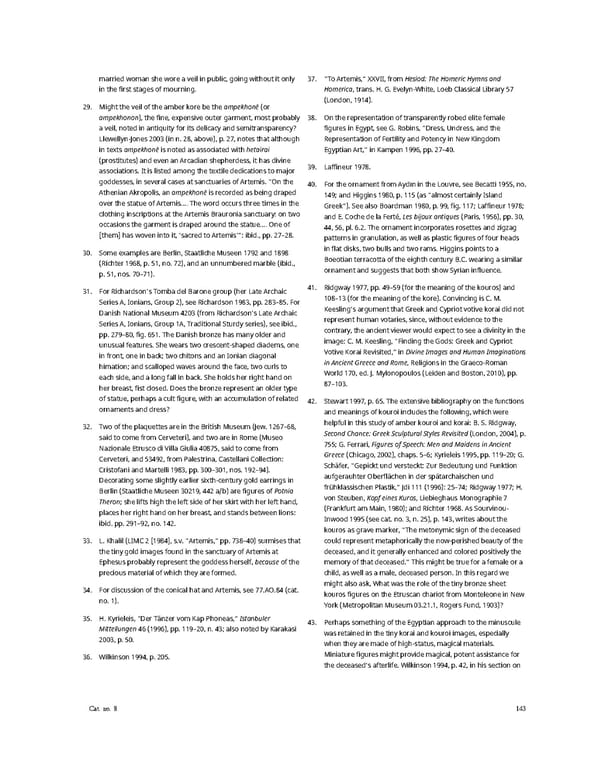married woman she wore a veil in public, going without it only 37. “To Artemis,” XXVII, from Hesiod: The Homeric Hymns and in the first stages of mourning. Homerica, trans. H. G. Evelyn-White, Loeb Classical Library 57 29. Might the veil of the amber kore be the ampekhonē (or (London, 1914). ampekhonon), the fine, expensive outer garment, most probably 38. On the representation of transparently robed elite female a veil, noted in antiquity for its delicacy and semitransparency? figures in Egypt, see G. Robins, “Dress, Undress, and the Llewellyn-Jones 2003 (in n. 28, above), p. 27, notes that although Representation of Fertility and Potency in New Kingdom in texts ampekhonē is noted as associated with hetairai Egyptian Art,” in Kampen 1996, pp. 27–40. (prostitutes) and even an Arcadian shepherdess, it has divine 39. Laffineur 1978. associations. It is listed among the textile dedications to major goddesses, in several cases at sanctuaries of Artemis. “On the 40. For the ornament from Aydın in the Louvre, see Becatti 1955, no. Athenian Akropolis, an ampekhonē is recorded as being draped 149; and Higgins 1980, p. 115 (as “almost certainly Island over the statue of Artemis.… The word occurs three times in the Greek”). See also Boardman 1980, p. 99, fig. 117; Laffineur 1978; clothing inscriptions at the Artemis Brauronia sanctuary: on two and E. Coche de la Ferté, Les bijoux antiques (Paris, 1956), pp. 30, occasions the garment is draped around the statue.… One of 44, 56, pl. 6.2. The ornament incorporates rosettes and zigzag [them] has woven into it, ‘sacred to Artemis’”: ibid., pp. 27–28. patterns in granulation, as well as plastic figures of four heads 30. Some examples are Berlin, Staatliche Museen 1792 and 1898 in flat disks, two bulls and two rams. Higgins points to a (Richter 1968, p. 51, no. 72), and an unnumbered marble (ibid., Boeotian terracotta of the eighth century B.C. wearing a similar p. 51, nos. 70–71). ornament and suggests that both show Syrian influence. 31. For Richardson’s Tomba del Barone group (her Late Archaic 41. Ridgway 1977, pp. 49–59 (for the meaning of the kouros) and Series A, Ionians, Group 2), see Richardson 1983, pp. 283–85. For 108–13 (for the meaning of the kore). Convincing is C. M. Danish National Museum 4203 (from Richardson’s Late Archaic Keesling’s argument that Greek and Cypriot votive korai did not Series A, Ionians, Group 1A, Traditional Sturdy series), see ibid., represent human votaries, since, without evidence to the pp. 279–80, fig. 651. The Danish bronze has many older and contrary, the ancient viewer would expect to see a divinity in the unusual features. She wears two crescent-shaped diadems, one image: C. M. Keesling, “Finding the Gods: Greek and Cypriot in front, one in back; two chitons and an Ionian diagonal Votive Korai Revisited,” in Divine Images and Human Imaginations himation; and scalloped waves around the face, two curls to in Ancient Greece and Rome, Religions in the Graeco-Roman each side, and a long fall in back. She holds her right hand on World 170, ed. J. Mylonopoulos (Leiden and Boston, 2010), pp. her breast, fist closed. Does the bronze represent an older type 87–103. of statue, perhaps a cult figure, with an accumulation of related 42. Stewart 1997, p. 65. The extensive bibliography on the functions ornaments and dress? and meanings of kouroi includes the following, which were 32. Two of the plaquettes are in the British Museum (Jew. 1267–68, helpful in this study of amber kouroi and korai: B. S. Ridgway, said to come from Cerveteri), and two are in Rome (Museo Second Chance: Greek Sculptural Styles Revisited (London, 2004), p. Nazionale Etrusco di Villa Giulia 40875, said to come from 755; G. Ferrari, Figures of Speech: Men and Maidens in Ancient Cerveteri, and 53492, from Palestrina, Castellani Collection: Greece (Chicago, 2002), chaps. 5–6; Kyrieleis 1995, pp. 119–20; G. Cristofani and Martelli 1983, pp. 300–301, nos. 192–94). Schäfer, “Gepickt und versteckt: Zur Bedeutung und Funktion Decorating some slightly earlier sixth-century gold earrings in aufgerauhter Oberflächen in der spätarchaischen und Berlin (Staatliche Museen 30219, 442 a/b) are figures of Potnia frühklassischen Plastik,” Jdi 111 (1996): 25–74; Ridgway 1977; H. Theron; she lifts high the left side of her skirt with her left hand, von Steuben, Kopf eines Kuros, Liebieghaus Monographie 7 places her right hand on her breast, and stands between lions: (Frankfurt am Main, 1980); and Richter 1968. As Sourvinou- ibid. pp. 291–92, no. 142. Inwood 1995 (see cat. no. 3, n. 25), p. 143, writes about the kouros as grave marker, “The metonymic sign of the deceased 33. L. Khalil (LIMC 2 [1984], s.v. “Artemis,” pp. 738–40) surmises that could represent metaphorically the now-perished beauty of the the tiny gold images found in the sanctuary of Artemis at deceased, and it generally enhanced and colored positively the Ephesus probably represent the goddess herself, because of the memory of that deceased.” This might be true for a female or a precious material of which they are formed. child, as well as a male, deceased person. In this regard we 34. For discussion of the conical hat and Artemis, see 77.AO.84 (cat. might also ask, What was the role of the tiny bronze sheet no. 1). kouros figures on the Etruscan chariot from Monteleone in New York (Metropolitan Museum 03.21.1, Rogers Fund, 1903)? 35. H. Kyrieleis, “Der Tänzer vom Kap Phoneas,” Istanbuler 43. Perhaps something of the Egyptian approach to the minuscule Mitteilungen 46 (1996), pp. 119–20, n. 43; also noted by Karakasi was retained in the tiny korai and kouroi images, especially 2003, p. 50. when they are made of high-status, magical materials. 36. Wilkinson 1994, p. 205. Miniature figures might provide magical, potent assistance for the deceased’s afterlife. Wilkinson 1994, p. 42, in his section on Cat. no. 8 143
 Ancient Carved Ambers in the J. Paul Getty Museum Page 152 Page 154
Ancient Carved Ambers in the J. Paul Getty Museum Page 152 Page 154